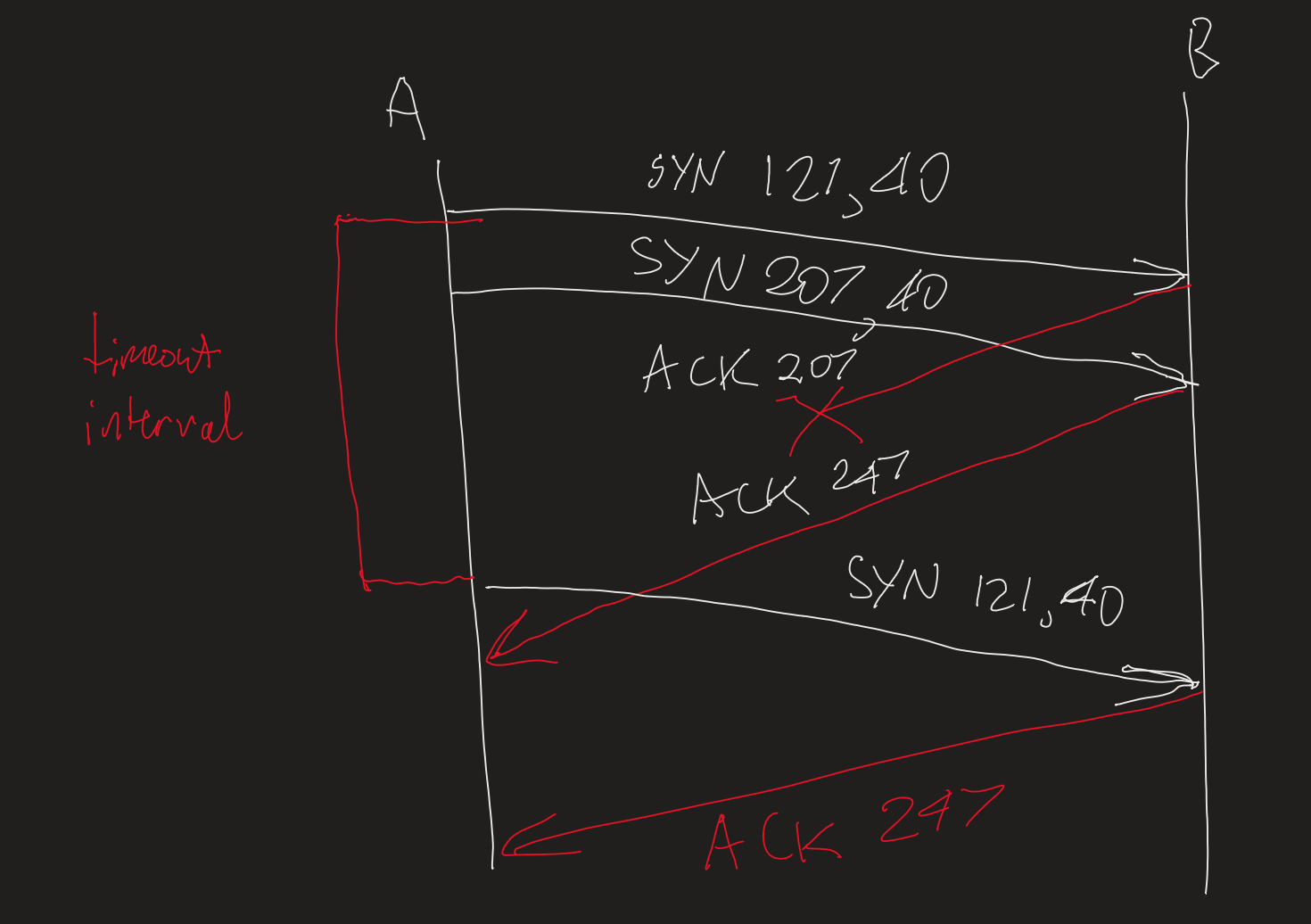Computer Systems
Tutorial 5: TCP + git
Tutorial Week 5
Transport Layer: TCP (plus git)
1. Consider a TCP connection between Host A and Host B. Suppose that the TCP segments traveling from Host A to Host B have source port number x and destination port number y. What are the source and destination port numbers for the segments traveling from Host B to Host A?
- source port number: y
- destination port number: x
2. Suppose that a Web server runs in Host C on port 80. Suppose this Web server uses persistent connections, and is currently receiving requests from two different Hosts, A and B. Are all of the requests being sent through the same socket at Host C? If they are being passed through different sockets, do both of the sockets have port 80? Discuss and explain.
They use different sockets. For a persistent connection the web server
listens on port 80, and then spawns a new socket with a different port number
Typically the web server will have a single process with a thread for each connection socket, or could
use separate processes with individual sockets.
StackOverflow: How multiple clients connect to port 80

3. A negative acknowledgement tells the sender that a particular packet has not been received, rather than that a packet has been received. Consider a reliable data transfer protocol that uses only negative acknowledgments. Suppose the sender sends data only infrequently. Would a NAK-only pro- tocol be preferable to a protocol that uses ACKs? Why? Now suppose the sender has a lot of data to send and the end-to-end connection experiences few losses. In this second case, would a NAK-only protocol be preferable to a protocol that uses ACKs? Why?
- NAK only: Would not be preferable; if there was a single segment sent, the receiver would be unaware they had missing data until the next segment was received and so there would be a substantial delay in recovery
- Second case: NAK-only would have much less overhead because there only needs to be a NAK for a lost packet, and the response time would be short because lots of data is being transmitted
4. Suppose Host A sends two TCP segments back to back to Host B over a TCP connection. The first segment has sequence number 900; the second has sequence number 1024.
(a) How much data is in the first segment?
data: 1024-900=124 bytes
(b) Suppose the first segment is lost but the second segment arrives at B. In the acknowledgement that Host B sends to Host A, what will be the acknowledgement number?
900
(c) Suppose that now the third segment with sequence number of 1124 from Host A arrives to Host B, and the second segment is still missing. What will be the acknowledgement number?
1024
5. Host A and B are communicating over a TCP connection, and Host B has already received from A all bytes up through byte 126. Suppose Host A then sends two segments to Host B back-to-back. The first and second segments contain 80 and 40 bytes of data, respectively. In the first segment, the sequence number is 127, the source port number is 302, and the destination port number is 80. Host B sends an acknowledgment whenever it receives a segment from Host A.
(a) In the second segment sent from Host A to B, what are the sequence number, source port number, and destination port number?
sequence number: 127+80=207 source port number: 302 destination port number: 80
(b) If the first segment arrives before the second segment, in the acknowl- edgment of the first arriving segment, what is the acknowledgment number, the source port number, and the destination port number?
ack. number: 207 source port number: 80 destination port number: 302
(c) If the second segment arrives before the first segment, in the acknowl- edgment of the first arriving segment, what is the acknowledgment number?
ack. number: 127
(d) Suppose the two segments sent by A arrive in order at B. The first acknowledgment is lost and the second acknowledgment arrives after the first timeout interval. Draw a timing diagram, showing these segments and all other segments and acknowledgments sent. (As- sume there is no additional packet loss.) For each segment in your figure, provide the sequence number and the number of bytes of data; for each acknowledgment that you add, provide the acknowledgment number.
 _6. A reliable data transfer should provide two guarantees:
- the delivery of the packet, i.e., no packet loss;
- protection against accidental errors, i.e., packets corrupted by ran- dom changes of bits will not be delivered.
It does not guarantee in-order delivery; we say “TCP provides reliable, in-order delivery” because reliable does not imply in-order. What other notions of “reliability” are there, and at what layers are they provided?
- tcp checksum is not robust: high probability of collisions; not collision resistant
- multiple payloads can generate the same checksum
- adversary could interfere
- mitigant: use digital signatures (cryptography); guarantees integrity
- not clear if origin is authentic: need authentication as well; provided with certificates
- HTTPS
- privacy: encryption via TLS (OSI model layer 5); between transport layer/and application layer
7. Imagine you were going to reimplement git. What algorithm would you use to merge two sets of changes to a text file? Think about how fast your scheme would be, and how accurate it would be.
stackoverflow: how does git merge work?
- find a merge base, i.e. common ancestor of two candidates
- perform diffs of each candidate against the merge base
- walk through diffs:
- if both sides have the change, accept it
- if one side has the change, the other has no change in that region, accept the change
- if both sides have changes, mark a conflict for manual resolution